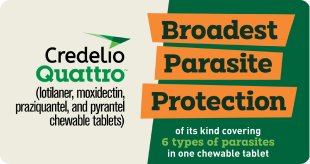Fluoxetine
Prescription required.
You already have a

subscription.
You already have a

subscription in cart.
Your order may arrive in two packages. We ship non-Rx items without delay while the Rx approval is pending. You will receive two tracking numbers.
Prescription required.
You already have a

subscription.
You already have a

subscription in cart.
Your order may arrive in two packages. We ship non-Rx items without delay while the Rx approval is pending. You will receive two tracking numbers.


What is Fluoxetine?
Fluoxetine is an antidepressant belonging to a group of drugs called selective serotonin reuptake inhibitors (SSRI). Fluoxetine is used in dogs and cats for the treatment of canine aggression and obsessive-compulsive disorder. Fluoxetine requires a prescription from your veterinarian. Tablets are sold individually.
For:
Cats and Dogs
Benefits:
- Helps with obsessive compulsive behaviors such as tail chasing in dogs, or constant licking in dogs and cats, and other behavioral disorders which are otherwise common causes for veterinary visits
- Easy to administer
How does Fluoxetine work?
Fluoxetine affects chemicals in the brain that can cause depression, panic, anxiety, or obsessive-compulsive behaviors. It may take up to 3 or 4 weeks before the medication becomes effective.
Cautions:
Avoid giving other medicines that can make your pet sleepy (cold or allergy medicine, pain medication, muscle relaxants, seizure medicine, or other medications for depression or anxiety). Do not give Reconcile if your pet is using an MAO inhibitor such as Anipryl, selegiline, Preventic Collar, or Mitaban Dip. Side effects that may occur include rash, hives, difficulty breathing, or swelling of the face, lips, tongue, or throat. If these or any other side effects occur, stop giving your pet Fluoxetine and contact your veterinarian.
Brand Name:
Prozac (Dista), Reconcile (Lilly)
Generic Name:
Fluoxetine (flew-ox-a-teen) HCl
What should I discuss with my veterinarian before giving Fluoxetine?
Tell your veterinarian if your pet is allergic to any medications of if your pet has liver disease, kidney disease, diabetes, or seizures. Notify your veterinarian if your pet is pregnant, if you are planning to breed your pet, or if your pet is lactating.
What is the most important information I should know about Fluoxetine?
Do not give Fluoxetine with a monoamine oxidase inhibitor (MAOI) such as Anipryl, selegiline, Preventic Collar or Mitaban Dip. Call your veterinarian at once if new or worsening symptoms such as mood or behavior changes, anxiety, trouble sleeping, irritability, agitation, hostile behavior, aggression, restlessness, hyperactivity.
How should Fluoxetine be given?
Give Fluoxetine exactly as prescribed by your veterinarian. If you do not understand the directions ask your pharmacist or veterinarian to explain them to you. Do not give larger amounts or give it for longer than recommended by your veterinarian. Your veterinarian may occasionally change the dose to achieve the best result. It may take 3 to 4 weeks or longer before Fluoxetine takes effect. Do not stop using Fluoxetine without first consulting with your veterinarian. Unpleasant side effects can occur if the medication is stopped suddenly. Store Fluoxetine at room temperature away from moisture and heat. Keep this medication away from children and other pets.
What are the possible side effects of Fluoxetine?
If any of the following serious side effects occur, stop giving Fluoxetine and seek emergency veterinary medical attention; an allergic reaction (skin rash or hives, difficulty breathing, swelling of the face, lips, tongue, or throat). Call your veterinarian at once if your pet has any new or worsening symptoms such as mood or behavior changes, anxiety, panic attacks, trouble sleeping, irritability, agitation, hostility, aggression, restlessness, hyperactivity, or increased depression. Call your veterinarian at once if your pet has any serious side effects such as; seizures (convulsions); tremors, shivering, muscle stiffness or twitching; a red, blistering, peeling skin rash; problems with balance or coordination; or agitation, confusion, sweating, fast heartbeat. Less serious side effects may include drowsiness, dizziness, weakness, runny nose, sore throat, nausea, diarrhea, changes in appetite, weight changes, dry mouth. Other side effects may also occur. Talk to your veterinarian about any side effect that seems unusual or bothersome to the animal.
What happens if I miss giving a dose of Fluoxetine?
Give the missed dose as soon as you remember. However, if it is almost time for the next regularly scheduled dose, skip the missed the missed dose and give the next one as directed. Do not give a double dose of the medication.
What should I avoid while giving Fluoxetine to my pet?
Avoid giving other medicines that can make the pet sleepy such as; cold or allergy medicine, pain medication, muscle relaxers, seizure medicine, or other medications for depression or anxiety. Tell your veterinarian if you give your pet any of these medications regularly.
What other drugs will affect Fluoxetine?
Talk to your veterinarian before giving your pet any medicine for pain, arthritis, fever, or swelling. This includes carprofen, piroxicam, etodolac, and others. Giving any of these medications with Fluoxetine may cause the pet to bruise or bleed easily. Before giving Fluoxetine, tell your veterinarian if your pet is being given digoxin, diazepam (Valium), phenytoin (Dilantin), warfarin (Coumadin), amitriptyline (Elavil), imipramine (Tofranil). Drugs other than those listed may also interact with Fluoxetine. Talk to your veterinarian or pharmacist before giving any prescription or over the counter medicines including herbal supplement.


Fluoxetine Directions:
- Fluoxetine is an antidepressant drug in a group of drugs called selective serotonin reuptake inhibitors (SSRI).
- Fluoxetine is available by prescription and is used to treat separation anxiety and obsessive compulsive behaviors in dogs and inappropriate elimination in cats.
Do not give larger amounts or give for longer than recommended by your veterinarian. It may take 3 to 4 weeks or longer before Fluoxetine takes effect. Do not stop Fluoxetine without first consulting with your veterinarian.
Fluoxetine Dosage:
| Weight | Dosage |
|---|---|
| All weights | Dosage is dependent on the condition being treated, the animal's response to treatment, and the development of any adverse effects. Give exactly as directed by your veterinarian |
| Weight | Dosage |
|---|---|
| All weights | Dosage is dependent on the condition being treated, the animal's response to treatment, and the development of any adverse effects. Give exactly as directed by your veterinarian |
| Horses | Do not use! |
|---|
Storage:
Store this medication at room temperature away from heat and moisture.


Fluoxetine Ingredients:
| Active Ingredient (per tablet) | Amount |
|---|---|
| Fluoxetine Hydrochloride | 10 mg |
| Active Ingredient (per capsule) | Amount |
|---|---|
| Fluoxetine Hydrochloride | 10 mg |
| Active Ingredient (per tablet) | Amount |
|---|---|
| Fluoxetine Hydrochloride | 20 mg |
| Active Ingredient (per tablet) | Amount |
|---|---|
| Fluoxetine Hydrochloride | 40 mg |


 Swipe
Swipe

















































